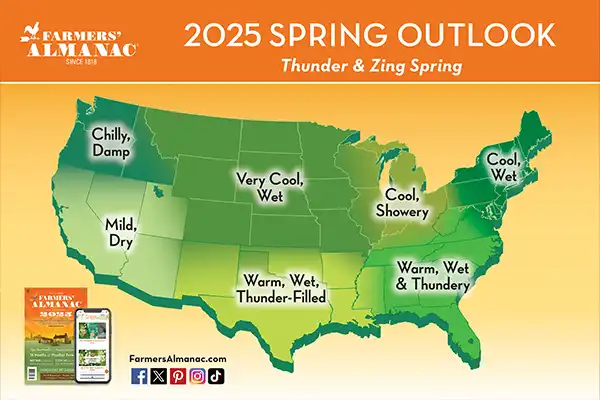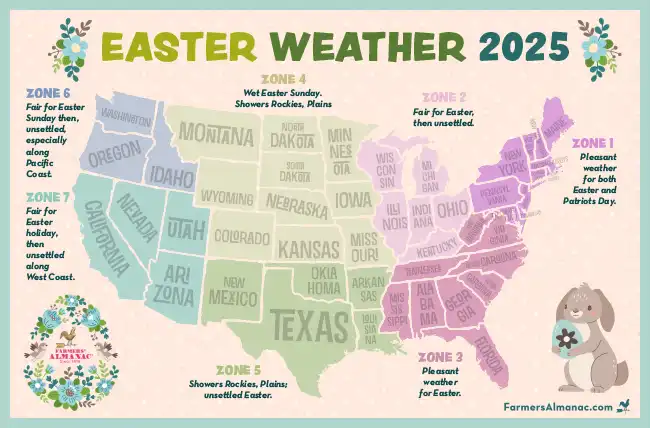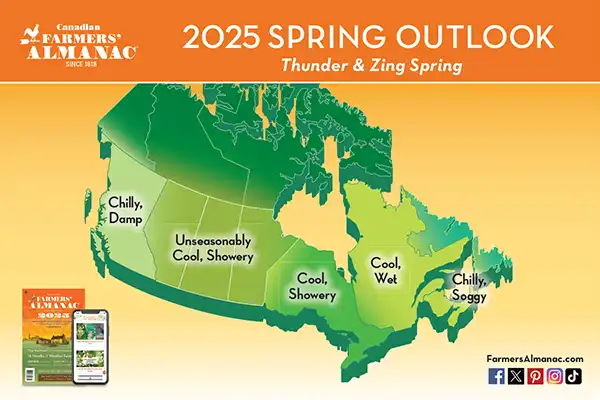Here in the Northern Hemisphere, we welcome spring on Thursday, March 20, 2025, at 5:01 a.m. EDT (2:01 a.m. Pacific) with the arrival of the spring equinox. But will the season and the weather be on the same page? The question on everyone’s mind is, “when will weather warm up?” Here’s the Farmers’ Almanac spring forecast, including Easter weather and Memorial Day weather predictions.
Start by watching this video (after a short word from our sponsor):
Spring Forecast 2025 – United States
Get ready for a “Thunder and Zing Spring!” Farmers’ Almanac long range weather forecast says spring weather will take its time arriving, allowing winter conditions to linger, especially across the Midwest, Great Lakes, New England, and Northeast regions.
An unusually late winter storm brings a blanket of rain, sleet, and snow across the Atlantic Seaboard and mountainous areas in the Southeast during the first week of April.

Spring storms will bring plenty of showers and thunder for most areas, except for the Southwest, which could see a drier-than-usual season. Texas and the South Central States will experience a warm, wet spring that may spawn many thunderstorms.
Temperatures will run somewhat coolish for the northern and central regions, especially for the Pacific Northwest, even into the month of June. The exceptions will be across the Southern States, where temperatures are expected to run a bit milder than average.
Overall, we see a cool and stormy season for most places of the United States. (Jump to Canada’s Spring 2025 Weather Forecast.) The exceptions will be in The Southeast and South Central states, where temperatures will be a bit warmer, but even areas in the Southwest will see a slow warm-up.
Spring Showers During Events?
Many major outdoor events are held during the spring season. The opening rounds of the Masters Golf Tournament in Augusta, Georgia, should see showers, though we hope for clearing to arrive in time for the final round on April 13.
Patriots’ Day in New England, which is also the date for the Boston Marathon (April 21), should be pleasantly fair and clear.
As for horse racing’s triple crown, we’re predicting a dry track for the Kentucky Derby on May 3, a clearing trend arriving in Pimlico, Maryland, for the Preakness on May 17, and sun-filled skies for the Belmont on June 7.
The Indianapolis-500, however, could be marred by wet weather on May 25.
RELATED: “The louder the frog, the more the rain” and other fun spring weather lore sayings
Will the weather impact your Easter Sunday plans? (See Easter weather below.)
United States Easter Weather Forecast
Easter is on Sunday, April 20, 2025. As you plan your day, knowing what the weather might be like is really important. Should you bring a rain jacket for your Easter egg hunt, or should you wear a warm coat instead? Here’s what the Farmers’ Almanac is predicting for your Easter weekend: Sunday, April 20-Wednesday, April 23, 2025.
Zone 1 – Northeast & New England
New York, Vermont, New Hampshire, Maine, Massachusetts, Rhode Island, Connecticut, Pennsylvania, New Jersey, Delaware, Maryland, Washington D.C.
Pleasant weather for both Easter and Patriots’ Day.

Zone 2 – Great Lakes, Ohio Valley & Midwest
Ohio, Michigan, Indiana, Kentucky, Illinois, Wisconsin
Fair for Easter, then unsettled.
Zone 3 – Southeast
Tennessee, Virginia, West Virginia, North Carolina, South Carolina, Georgia, Alabama, Mississippi, Florida
Pleasant weather for Easter.
Zone 4 – North Central
Missouri, Iowa, Minnesota, North Dakota, South Dakota, Nebraska, Kansas, Colorado, Wyoming, Montana
Wet Easter Sunday. Showers Rockies, Plains.
Zone 5 – South Central
Arkansas, Louisiana, Oklahoma, Texas, New Mexico
Showers Rockies, Plains; unsettled Easter.
Zone 6 – Northwest
Washington, Oregon, Idaho
Fair for Easter Sunday, then unsettled, especially along Pacific Coast.
Zone 7 – Southwest
California, Nevada, Utah, Arizona
Fair for Easter holiday, then unsettled along West Coast.
Memorial Day Weather Forecast
Here are the Farmers’ Almanac long-range weather predictions for Memorial Day (from Saturday, May 24, through Tuesday, May 27, 2025). As you will find, we expect rain for most weather zones. We hope that everyone has a safe and pleasant holiday, whatever the weather brings!
Zone 1 – Northeast & New England
New York, Vermont, New Hampshire, Maine, Massachusetts, Rhode Island, Connecticut, Pennsylvania, New Jersey, Delaware, Maryland, Washington D.C.
Pleasant, then very breezy with showers, hopefully holding off until after Memorial Day.
Zone 2 – Great Lakes, Ohio Valley & Midwest
Ohio, Michigan, Indiana, Kentucky, Illinois, Wisconsin
Unsettled weather spreads into Ohio Valley, unfortunately dampening Memorial Day weekend. Indy-500 could be wet.
Zone 3 – Southeast
Tennessee, Virginia, West Virginia, North Carolina, South Carolina, Georgia, Alabama, Mississippi, Florida
Heavy rains put a damper on the holiday weekend.
Zone 4 – North Central
Missouri, Iowa, Minnesota, North Dakota, South Dakota, Nebraska, Kansas, Colorado, Wyoming, Montana
Unsettled weather in Colorado. Points east: wet on Memorial Day.
Zone 5 – South Central
Arkansas, Louisiana, Oklahoma, Texas, New Mexico
Heavy rains TX, LA make for a very wet holiday weekend.
Zone 6 – Northwest
Washington, Oregon, Idaho
Unsettled for holiday weekend.
Zone 7 – Southwest
California, Nevada, Utah, Arizona
Problematic weather for the holiday: unsettled weather from West Coast, points east, through UT; skies threatening over the rest of the Southwest.
Get Growing With The Farmers’ Almanac Spring Forecast 2025!
Spring is gardening season! Here are 7 essential tips for getting your gardens going:
- Map out your garden’s layout: Select plant species that align with your vision. Account for crucial elements such as the amount of sunlight each area receives, the soil composition, and the spatial dynamics at hand. A strategic blueprint is the cornerstone of a flourishing garden.
- Enhance your soil: Assess and enrich the soil by integrating organic substances like compost or decomposed manure. This process supports fertility, optimizes drainage, and improves water retention, creating a prime habitat for robust plant development.
- Select seeds that are best for your environment. Whether starting from seeds or transplanting, compatibility with your garden’s microclimate is crucial for success. Also, be sure to check for seed viability: Are Your Seeds Still Good? Here’s How To Tell! Plus, here are more seed-starting tips.
- Timing is important: Stick to the planting timeline according to your region’s last frost date to set yourself up for the most success.
- Establish a regular watering schedule: A regular watering schedule that provides hydration without excess is essential. An investment in a drip irrigation system or soaker hoses can be advantageous, maintaining consistent soil moisture and reducing water consumption.
- Mulching: Mulching deters weeds, conserves moisture within the soil, and stabilizes temperature fluctuations. This practice improves the aesthetic appeal of your garden and also serves as a protective layer for plant roots.
- Pest prevention: Engage in continuous observation and maintenance of your garden to identify and manage potential pests, diseases, or nutrient imbalances promptly. Conscientious care, including regular pruning and deadheading, fosters plant health and encourages vigorous growth and flowering.
RELATED: Gardening By The Moon – Planting Calendar
Note: The spring season may bring persistent late frosts and occasional snowstorms, which can have a detrimental impact on agricultural production and property, resulting in losses. See below …
Navigating Spring Weather: An Advisory
The stretch from March to June in the United States is known for significant weather changes, especially as we transition from the colder months of winter into warmer ones. States such as Texas, Oklahoma, Missouri, Mississippi, Alabama, and Georgia—noted by Sperling (via New York Times) as some of the riskiest places for weather-related challenges—typically experience the most dramatic shifts. Yet, the unpredictability of spring’s temperament is a national occurrence, influencing all regions.
Throughout the spring season, preparedness for a variety of weather events is essential. This period marks the onset of tornado season across southern and midwestern states, heralding not only the threat of tornadoes but also the incidence of related weather events including thunderstorms, hail, lightning, and the possibility of derechos—intense wind storms that can cause significant damage.
As spring progresses, certain areas may experience early heatwaves, while coastal regions in the southeast may begin to see the first signs of hurricane or tropical storm activity. Additionally, the likelihood of flooding is at its peak during spring. Preparation is key!

Spring Weather Forecast 2025 – Canada
Spring will see a slow start with wintry conditions lingering across Great Lakes, Quebec and the Maritimes. Another Red Flag time frame is forecast for the first week of April where we are forecasting an unusually late winter storm bringing a broad area of rain, sleet and snow across Atlantic Canada. Much of the rest of the country will see frequent and widespread showers.
During the first week of April across the Prairies, there may be the threat of strong-to-severe weather. Temperatures will run somewhat coolish, especially so for British Columbia, even into the month of June. Curious about the weather for Victoria Day? See details of your weather zone here.
Canadian Easter Forecast
Here’s what weather the Farmers’ Almanac is predicting for Canada’s Easter weekend, Sunday, April 20-Wednesday, April 23, 2025.
Zone 1
Newfoundland, Labrador
A wet Easter with rainy skies; then turning fair.
Zone 2
Nova Scotia, Prince Edward Island, New Brunswick, Quebec
Pleasant weather for Easter.
Zone 3
Ontario
Fair for Easter, then unsettled.
Zone 4
Alberta, Manitoba, Saskatchewan
Wet Easter Sunday with showers Rockies, Prairies.
Zone 5
British Columbia
Fair for Easter Sunday, then unsettled, especially along Pacific Coast.
Join The Discussion
How do you feel about the Farmers’ Almanac spring forecast?
What are you looking forward to most about spring 2025?
Planning any fun activities? Let us know in the comments below!


[…] Spring weather patterns extending into summer have become increasingly common in recent years, influencing the Father’s Day 2025 temperature forecast for both New York and Indianapolis. The persistent cool pattern reflects larger-scale atmospheric trends affecting much of the eastern United States. […]
I am making a good salary from home $4580-$5240/week , which is amazing under a year ago I was jobless in a horrible economy. I thank God every day I was blessed with these instructions and now its my duty to pay it forward and share it with Everyone,
Here is I started… . . . . . .>>> Www.Work44.Com
I’ve relied on the Farmers’ Almanac for years to forecast the weather while working at the Masters, and it’s been incredibly accurate. Based on this year’s prediction, I know a heavier rain suit is a must.
While I do respect the Farmers Almanac and its rich history I also find Zone 5 for Texas to be much too general and not accurate. In Central TX specifically here in Fredericksburg, we seldom receive storms much less any measurable precipitation. Continued multi year drought is our pattern.
Hi Mark, we do our best to try to forecast for the whole country, a year in advance, but it is tough. Appreciate you being here and leaving your comment!
Changeable skys what the heck kind of a forcast is that. ?
In Central Western Maine, the last growing season was the worst. Will it be a rainy season this year? I lost most of my plants last year, don’t want to make that mistake again if I can help it. Thanks.
Thank you…this is helpful information.
Thanks this is helpful
You are welcome!